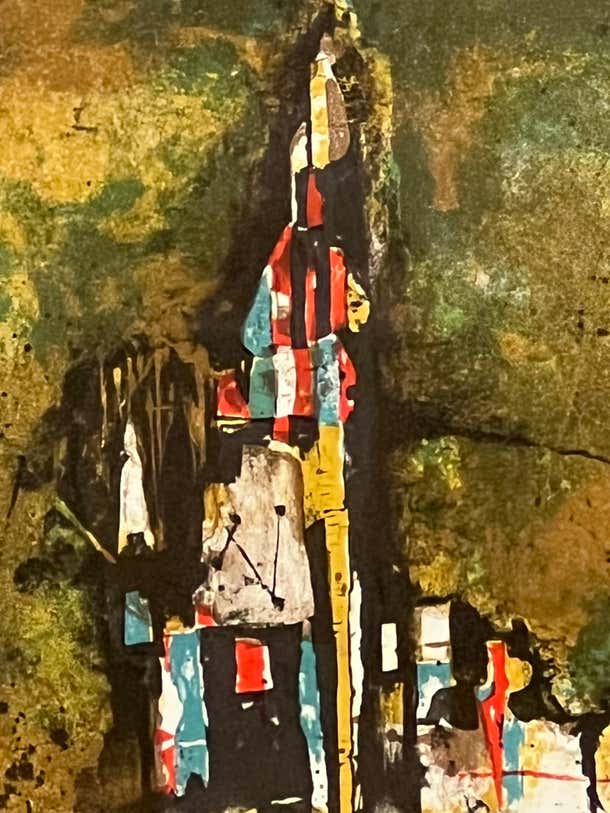Galerie Sommerlath
Abstract Lithograph by Johnny Friedlander
Abstract Lithograph by Johnny Friedlander
Couldn't load pickup availability
Art, a tangible manifestation of the imaginary and the sensitive, is translated through works capable of captivating and communicating beyond words. Friedlaender's lithographs, loaded with this expressive force, emerge before our eyes like metaphorical windows that open onto deep emotional spheres.
At the heart of this piece are lines, spikes, vertical shapes, colors, and the manipulation of textures and vectors of wild expressiveness. Known as a "painter of the night" in some of his works and hailed for his innovative use of techniques such as aquatint etching, Friedlaender explores what few manage to confront: the dark abysses of the psyche and the blurred contours of our deepest dreams.
It is a geometric interpretation that comes to life with its oblong shapes and sharp lines, which echo the rigid policies of metropolitan architecture. However, it also strangely resembles biological structures, such as an urban skeleton.
The aesthetics of the chosen colors - the red of passion, the blue of wisdom, the yellow of energy, the white of purity - and their arrangement recall traditional stained glass windows, illustrating the symbolism of colors in sacred art. This aspect encourages us to consider a dimension of transparency and controlled light, which filters emotions in such a way as to lead us as an observer to an intimate and personal reflection.
The work studied is complex and nocturnal, and we are carried away into a universe where the city represents itself as the architecture of our collective coexistence.
- B I O - Courtesy From Artnet
Johnny Friedlaender (German, 1912–1992) was an artist best known for his pioneering use of aquatint etching. Born in Pless in the former German kingdom of Prussia, Friedlaender attended the Academy of Arts in Breslau, where he studied lithography and etching under Expressionist artist Otto Mueller.
In 1930, he moved to Dresden, where his work was included in group exhibitions at Galerie J. Sandel, and in 1936, he traveled to Czechoslovakia, Switzerland, Austria, France, and Belgium. Friedlaender spent most of his adult life in Paris after fleeing Nazi Germany in 1937. Between 1938 and 1939, Friedlaender worked at the literary magazine Marianne. From 1939 to 1943, he was interned in a series of concentration camps but was able to return to Paris after the war. In 1947, he became a member of the Salon de Mai, and in 1950, he became a French citizen.
Friedlaender worked for various journals and focused on etching as his primary medium. He quickly established a reputation as an innovator in color printmaking, and a school formed in Paris around his work.
In 1957, he received the Kamakura Prize at the Tokyo Biennial. In 1959, UNESCO awarded him a teaching post at the Museum of Modern Art in Rio de Janeiro. He continued traveling internationally throughout the rest of his career, holding exhibitions in Bern, Milan, Paris, and New York.
In 1978, he had his first retrospective at the Musee d’Art Moderne de la Ville de Paris. He was then given a retrospective at the Bremen Art Museum in Germany and the chancellery in Bonn. Friedlaender died in Paris at the age of 80.
REFERENCE NUMBER: LU654313938062
PERIOD: Mid-20th Century
CONDITION: Excellent
MEASUREMENTS: Height: 17" Width: 14.5" Depth: 0.6"
COUNT: 1
MATERIAL: Lithograph
CREATOR: Johnny Friedlander








-

Shipping
Shipment is arranged through recognized carriers such as UPS, FedEx, and DHL. Only pieces that can be safely packed in a box or envelope may be shipped via parcel. Shipping charges start at $49 — and vary based on the size, weight, packaging and the value of the item. Text (310) 531 7594 or call (310) 754 9494 to get a quote.
-

Returns
A return for this item may be initiated within 3 days of delivery.
*Return Shipping Fee
A restocking fee of 15% of the item price applies.
Buyer is responsible for return shipping charges and will not be reimbursed for the original shipping cost.
Additional Notes
Items must be returned in the same condition it was received otherwise restoration costs will be billed up to the full value of the item. Return shipment must be insured for full value.










